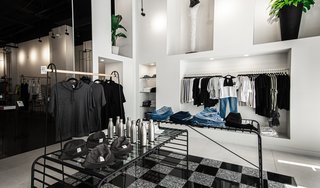By Jenny Xie – October 26, 2019
The only UNESCO City of Design in the U.S. is experiencing a cultural renaissance that you need to see for yourself.
Once an urban epicenter thanks to the automotive boom, Detroit, Michigan, has no doubt suffered from deindustrialization, its population plummeting from a peak of 1.86 million in 1950 to just over 673,000 in 2017. The aftermath has been well documented—urban decay, a crumbling social infrastructure, rampant unemployment—but in recent years, another narrative has emerged, and grown steadily louder: one of experimentation and revitalization.

As is often the case, young creatives are leading the charge. Artists, designers, and the like have been slowly transforming and reclaiming deserted neighborhoods, an effort that earned Motor City a new moniker as a UNESCO City of Design in 2015. To date, it’s the only city in the United States to have that designation.


Though it’s largely overshadowed by the legacy of the auto industry, design has always been part of Detroit’s DNA. The famed Cranbrook Academy of Art, located in nearby Bloomfield Hills, served as an “incubator” for midcentury luminaries like Eero Saarinen, Harry Bertoia, Charles and Ray Eames, Florence Knoll, and Niels Diffrient, to name a few—and continues to nurture the talents of today’s best and brightest. In 1949, the Detroit Institute of Art staged For Modern Living, an exhibition that declared a “new concept of beauty” for the modern home. Drive along the eastern edge of downtown Detroit and you’ll find Lafayette Park, a leafy enclave comprising the world’s largest collection of buildings designed by Mies van der Rohe (it’s also where Kyle Hoff, co-founder of the successful Detroit-based furniture company Floyd, lives). In neighboring Grosse Pointe Farms, you’ll find the last-standing home designed by Alexander Girard, who moved from New York to Detroit in 1937. The list goes on and on.


In September, the city celebrated its UNESCO City of Design designation with Detroit Month of Design. The program, organized by Design Core Detroit, celebrates the work of designers and organizations that have brought the city back into the limelight. “Artists and designers are central to the city’s revitalization,” says Olga Stella, executive director of Design Core Detroit. “They’re often the first ones working to improve neighborhoods. Often, the way they’re working is special because it is about building artistic expressions or design solutions that flow from the community itself.”


Take the case of Jack Craig, an artist who moved to Detroit nearly a decade ago to study at Cranbrook. After graduation, he lived and worked in Banglatown, a neighborhood known for its Bangladeshi-American residents and growing artist community. When his home and studio were sold, Craig bought a derelict, overgrown studio in McDougall-Hunt, another creative enclave. “I purchased my building from the Detroit Land Bank last spring,” he says. “It cost me as much to clean it as it did to buy it. The building didn’t have a roof, doors, or windows, and I removed 40 tons of debris and 400 tires just to clear it out, but I liked the scale and location.”

Thanks to the frontier spirit of folks like Craig, decaying communities have a chance at rehabilitation. Isabelle Weiss, Detroit native and founder of NEXT:SPACE, the city’s sole gallery focused on furniture and lighting by Detroit studio designers, agrees: “The climate for entrepreneurship is just right—not to say it is easy—and has been percolating for a while.” She cites new development downtown (fun fact: Quicken Loans founder Dan Gilbert owns some 100 buildings through his firm Bedrock Detroit), rising real estate prices, a hospitality boom, and an art and design scene that could only be born of Detroit.


“It’s not all just industrial-looking raw steel and reclaimed wood as some may think,” she cautions. “Detroit design stretches way beyond, in both concept and craft, though our industrial legacy does play a vital role. In Detroit and the metro area, you can get anything fabricated out of just about any material you can imagine. This allows many designers to develop a greater understanding of materials and process which, in turn, leads to greater experimentation.”

The danger, of course, is that larger developers will take advantage of the bushwhacking done by artists and designers, acquire healing neighborhoods, and build up in an exclusionary way. Philip Kafka, president of real estate company Prince Concepts, sees the opportunity to grow while engaging the city and its tough-as-nails spirit. Starting with True North, an award-winning live/work community comprising eight Quonset huts designed by architect Edwin Chan, Kafka has been bringing funk and vitality to a neighborhood known as Core City through residences and restaurants.


“Most developers are playing the standard game of buying in ‘safe’ areas and building an uninspired product,” says Kafka, who has advice to dispense: “Come on, guys, step it up! Loosen your ties and get out on the streets. This is an awesome and wild city—tough and difficult and even sad at times, but amazing and inspiring, too.”

Once again drawing national attention, Detroit is poised to model a more thoughtful regeneration than similar cities have seen. “Like many cities experiencing new investment, Detroit is struggling with how to ensure that economic growth is inclusive and equitable,” says Stella. “It’s important that the people who helped neighborhoods hold on through the toughest times can prosper as things get better.”
A Back-of-the-Envelope Guide to Detroit
We asked Olga Stella, Jack Craig, Isabelle Weiss, Philip Kafka, and Roslyn Karamoko to share some of their favorite places in Detroit. Think of it as your back-of-the-envelope city guide—by no means is it exhaustive, but it’s the cool kid’s entry point into wild and wonderful Detroit.
To See & Do:
Detroit Institute of Arts, Detroit Symphony Orchestra, Michigan Opera Theatre, The Henry Ford Museum, Cranbrook Art Museum, Playground Detroit, The Heidelberg Project, The Carr Center, The Ten Nail Bar, David Klein Gallery, Simone DeSousa Gallery
To Shop:
Détroit Is The New Black, Marketplace Antiques Gallery, Tom Gibbs Studio, Orleans and Winder, Hugh, The Lip Bar, DCreated Boutique
To Explore:
Belle Isle Park, Eastern Market, Lafayette Park
To Eat & Drink:
Trinosophes, Ochre Bakery, Astro Coffee, Rose’s Fine Food, Selden Standard, Takoi, Dearborn Meat Market, Two James Spirits
To Get Involved:
Knight Foundation, Build Institute, TechTown
Travel, meals, and accommodations for this story provided by Design Core Detroit
Original article: https://www.dwell.com/article/detroit-month-of-design-2019-57683575
The post Dwell // For the Most Exciting Design Scene No One’s Talking About, Head to Detroit appeared first on PLAYGROUND DETROIT.
